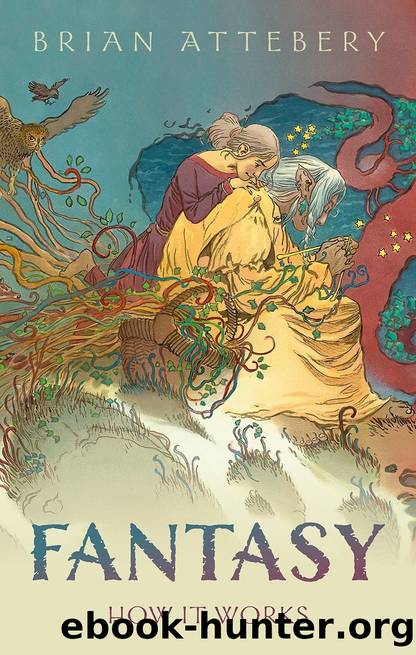Fantasy by Attebery Brian;

Author:Attebery, Brian; [Attebery, Brian]
Language: eng
Format: epub
Publisher: Oxford University Press, Incorporated
Published: 2022-01-30T00:00:00+00:00
7
Gender and Fantasy
Employing Fairy Tales
A significant chunk of the work of fantasy has to do with its being employed as a road map for journeys of growth and searches for identity. Modern fantasy inherits that job from the traditional fairy tale, which served the same function even before therapists started inviting patients to turn to myths and tales for personal insight and release from trauma. Though the process of identification with fairy-tale heroes and victims is a complex one, and ill-served by the distortions of writers such as Bruno Bettelheim, narrative therapy based in traditional fantastic literature is well established in professional practice (e.g., Silverman 2004, Runberg et al. 1993) as well as pop psychology. Long before Freud or Jung, people were using tales for solace, guidance, and a chance to vent otherwise inexpressible emotions. That comfort or release is, however, not equally available to all, and over the past century the personal and artistic use of fairy tales in particular, as opposed to myth and other collective oral narratives, has become mostly womenâs prerogative. The question whether men read or write fairy tales is an odd one. It wouldnât have occurred to readers of Hans Christian Andersen or Charles Perrault. Yet since the mid-twentieth century, the fairy tale has become a major form of artistic expression, self-examination, and political activism for women, while male writers and consumers are often made to feel like interlopers when they venture into the realm of the wonder tale. This imbalance puzzles me, as a lifelong devotee of fairy tale, and I set out a few years ago to explore how it came about and what sorts of strategies male writers employ to establish their own claim on the tales. This exploration eventually led to a 2018 article in the journal Marvels and Tales, which I will draw on in this chapter, but I wonât reproduce the article here. Articles prove theses; they have to make it look as if writers already know what they think and are simply laying out the case for their conclusions. As the text gets refined and edited, points are clarified and contradictions and digressions excised. But reality is not clear, and history does not have a single trajectory until some writer gives it one. So, if the reader will indulge me, I will go back over the process by which my thinking on this topic developed over time, and turn the argument into a sort of detective story. It represents a long journey I didnât even know I was taking until well along the way. There were many scenes of discovery on the path: a mix of âaha!â and âduhâ moments that I will try to label as I go.
A bit of a warning up front: talking about men and fairy tales is a hazardous business, because it looks like you are following the footsteps of chest-thumpers in the menâs rights movementâthink of Robert Bly misreading the tale of Iron Hans, whom he called âIron Johnâ and transformed from a nightmarish killer to a tutelary wild man (Zipes 1992, 16).
Download
This site does not store any files on its server. We only index and link to content provided by other sites. Please contact the content providers to delete copyright contents if any and email us, we'll remove relevant links or contents immediately.
4 3 2 1: A Novel by Paul Auster(11784)
The handmaid's tale by Margaret Atwood(7445)
Giovanni's Room by James Baldwin(6803)
Asking the Right Questions: A Guide to Critical Thinking by M. Neil Browne & Stuart M. Keeley(5355)
Big Magic: Creative Living Beyond Fear by Elizabeth Gilbert(5348)
Ego Is the Enemy by Ryan Holiday(4950)
On Writing A Memoir of the Craft by Stephen King(4658)
The Body: A Guide for Occupants by Bill Bryson(4578)
Ken Follett - World without end by Ken Follett(4441)
Bluets by Maggie Nelson(4258)
Adulting by Kelly Williams Brown(4230)
Eat That Frog! by Brian Tracy(4147)
Guilty Pleasures by Laurell K Hamilton(4114)
White Noise - A Novel by Don DeLillo(3828)
The Poetry of Pablo Neruda by Pablo Neruda(3813)
Fingerprints of the Gods by Graham Hancock(3731)
Alive: The Story of the Andes Survivors by Piers Paul Read(3725)
The Book of Joy by Dalai Lama(3692)
The Bookshop by Penelope Fitzgerald(3615)
